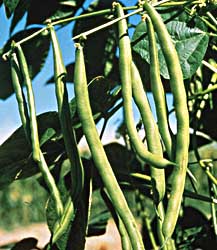
ole beans yield much longer than bush beans, right up to frost. Plant 4-6" apart at the base of poles, trellis, a fence or our Bean Tower. 2 oz. of seed per pack, enough for 20' of row or 10-16 poles, 1 lb. (16 oz.) for 80-128 poles or 160'. Kentucky Blue. 65 days. All-America Winner. Combines the excellence of the all-time greatest pole beans, Kentucky Wonder and Blue Lake. You get big crops of sweet and always stringless pods, straight and 7" long. A heavy yielder for many weeks. Sun.
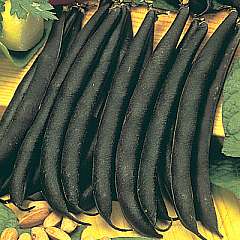
At last, a purple podded bean which bears its pods above the main foliage. This makes picking easier and ensures improved cropping of long straight pods with less soil splashing etc. Dwarf French Bean Purple Teepee produces pods that are approximately 6in long, stringless and slender with that intangible but appreciated zing to the flavour that many vegetable growers agree only comes to the purple podded types. Pods turn brilliant emerald green in boiling water. Quick maturing.
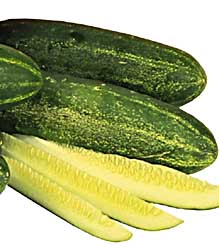
Cool, crisp flesh with great flavor. For perfect cukes, grow them on a fence or our space-saving Trellis Netting (p. 116). Sow seeds 6" apart in rows, or plant 5 or 6 seeds in groups (hills) 4-5' apart. 30 seeds per packet unless noted. Burpee Hybrid II. 55 days. Cool, crisp flesh with great flavor. This cuke's resistant to mosaic virus and downy mildew. Straight green fruits are about 8-1/2" long by 2-1/2" thick. Very high yielding, very early. Burpee Bred. Sun.
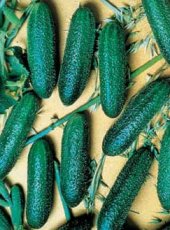
45 days. Cucumis sativus. (F1) Early variety produces huge yields of 4" long flavorful cucumbers without cross pollination, as there are no male flowers. Excellent for making sweet pickles. Plant yields as many as 50 cucumbers per plant. Parthenocarpic variety. Disease Resistant. pk/10
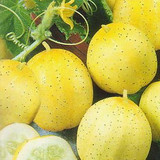
Our heirloom lemon cucumber is the perfect size for a single serving. They are an unusual change from normal cucumbers. A very productive heirloom variety of cucumber with a unique lemon color and baseball shape. Great flavor and crunchy texture with a non-bitter skin. You get loads of 2-3" fruit from mid- summer to fall. Terrific for pickling and slicing. Very easy to grow! Does well with short summer climates. This vine is also easy to grow in pots. Disease resistant and never bitter and easily digestible. 65 days
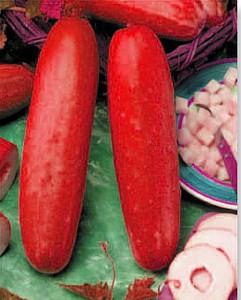
The fruits are white to pale green, turning orange-red as they ripen. A very productive and tasty variety that stays mild even when large. This heirloom was collected from a Hmong (Meo) immigrant. Millions of the Hmong tribe live on the borders of Thailand, China, Burma, Laos and Vietnam and are a very ancient people. (Seedmart, eBay)
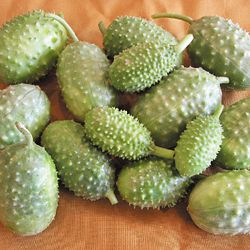
(Cucumis anguria) Large vines with distinctive looking leaves, more like watermelon than cucumbers. Large crops of oval fruits 2-3" long and 1½" in diameter. Distinct flavor, used for making small pickles or relish. Very drought tolerant. This variety dates back to at least the early 1790s. 60- 65 days. (Seed Savers Exchange)
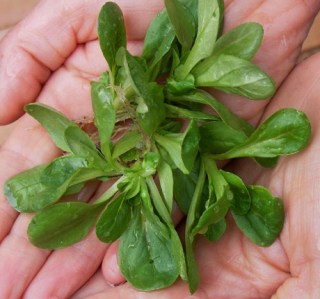
Mache (Valerianella locusta), also known as Lamb's Lettuce, Corn Salad, and Feldtsalat, is a cold-hardy European plant that was also grown in Thomas Jefferson's gardens at Monticello. 'Gala' is a new variety with a mild, nutty flavor and a melt-in-your-mouth texture. Sow in summer for harvest in 90 days in fall or early spring.
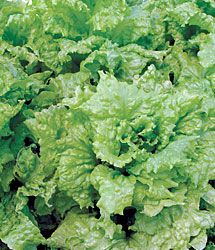
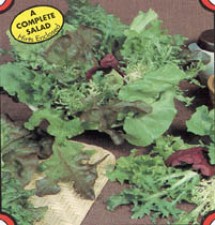
This special mild-flavored mix of lettuces is a complete salad in one seed packet. Packet contains the following lettuce varieties: Tango, Royal Oak Leaf, Red Salad Bowl, Black Seeded Simpson, Grand Rapids and Red Sails.
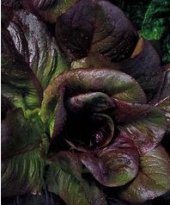
Plant produces a beautiful red Romaine that produces 10 to 12 inch bronze-red heads with a green heart. Leaves are loosely folded on heads. Excellent for salads and garnishes. One of the slowest to bolt lettuce on the market. Good for spring, summer and fall planting as it's cold-hardy and also tolerates heat. Grown in the US since the 18th century. pk/100
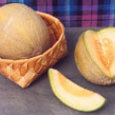
We have been partial to this Burpee melon since we first grew it. It is not the earliest, but acceptably so, with great dependability and a wonderful flavor. The fruits are round and heavily netted with a thick flesh and small seed cavity. They can be harvested a bit before they slip naturally.
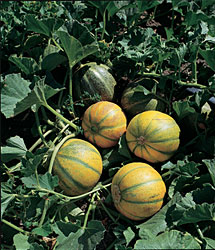
Sweet, fragrant, orange flesh. A delicious Charentais-type melon with blue-green skin, maturing to salmon-orange, and sweet, fragrant, orange flesh. Ready to harvest in about 80 days.
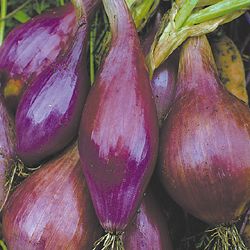
Hard- to-find Italian heirloom. Nice long bottle shaped bulbs. Excellent mild flavor. Very nice for using fresh. Can be sown in spring and fall in milder climates. 100-120 days from transplant. ±5,200 seeds/oz (Seed Savers Exchange)
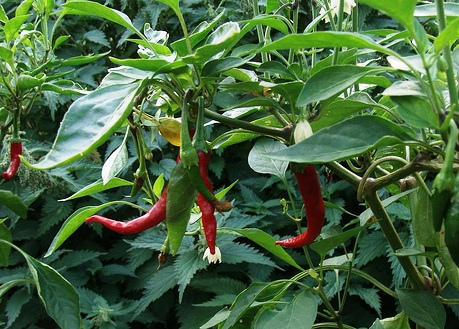
Very hot fruits 5 in. long and 1/2 in. thick. Use fresh or easily dried for winter use. Harvest starts about 75 days after plants are set out. CAUTION: Use rubber gloves, or clean hot peppers under running water, to avoid skin burn from the pepper juice.
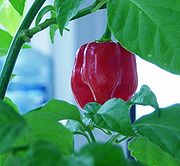
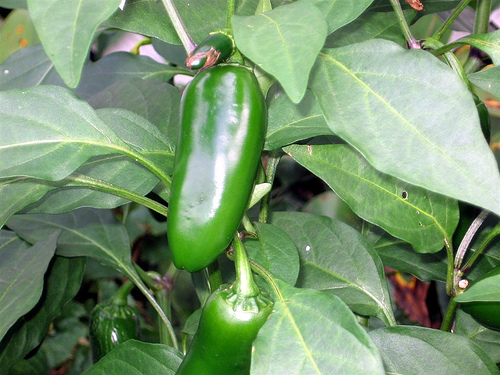
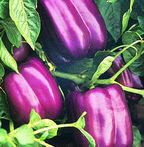
Not purple, but actually an unbelievably rich lilac-lavender shade that transforms while ripening! Fruits, 3 to 4-lobed, mature from ivory to lavender to red. Plants are Tobacco Mosaic Virus resistant.
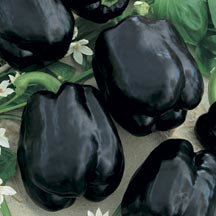
Intriguing Merlot is one of those varieties that look good on paper and prove to be even better in the garden! Rich, jewel-toned, 5 inch by 4 inch blocky fruits have gourmet eye-appeal, with crisp, thick walls and very sweet flavor. High-yielding plants mature early and are adaptable to weather conditions, growing 18 to 24 inches tall with good protection provided by lush foliage. Especially resistant to Tobacco Mosaic Virus and Bacterial Leaf Spot.
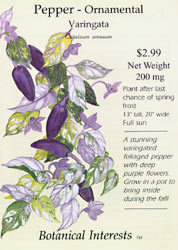
The Pepper Ornamental, ‘Caosicum annuum’, is a stunning variegated foliaged pepper with deep purple flowers. Why grow a pepper as an ornamental? Because ornamental peppers, particularly this one, may be the most beautiful plant in your flower garden. The Ornamental Pepper has white, light/medium/dark green variegated foliage with purple veins. Ornamental Peppers can be grown in the garden or grown in a pot to be brought inside when the temperatures begin to drop in the fall.
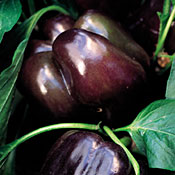
This stocky bell pepper is ready to eat when the fruits turn a stunning, deep purple with a green undertone. Crisp, succulent, 4-lobed, thick-walled fruit. Very productive.
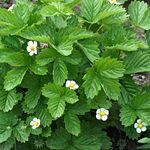
Lovely small white flowers with a yellow eye are followed by small strawberries all summer. Forming a tidy clump, this plant will also offer an excellent fall color. Great For: * Garden paths * Accent perennial Height: 8-10" Width: 8-16" Blooms: White (Spring, Summer, Fall) Fall Color: Orange, Red, Yellow
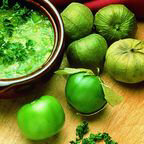
Unusual 2" fruits are harvested green - the husks are removed before cooking. A staple ingredient in Mexican Salsa Verde (green sauce). Tart, yellow-green fruits can also be used to add a distinctive taste to salads.
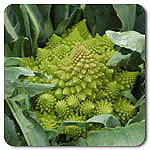
Brassica Oleracea var. botrytis "Fractal Food" for those drawn to the mathematics of nature, or "Italian cauliflower" in reference to this vegetable’s northern Italian roots dating back to the 15th century. Romanesco cauliflowers continue to gain popularity in the US as a gourmet vegetable that produces extraordinary heads with spirals upon spirals. Veronica has a unique chartreuse color in cool conditions and tends to be more of a creamy white in the summer with a blush of pink. More tender than traditional cauliflower, with a nutty flavor that is favored in crudite and other raw vegetable dishes. Large plants need 30-36” spacing. Days to maturity: 77 days